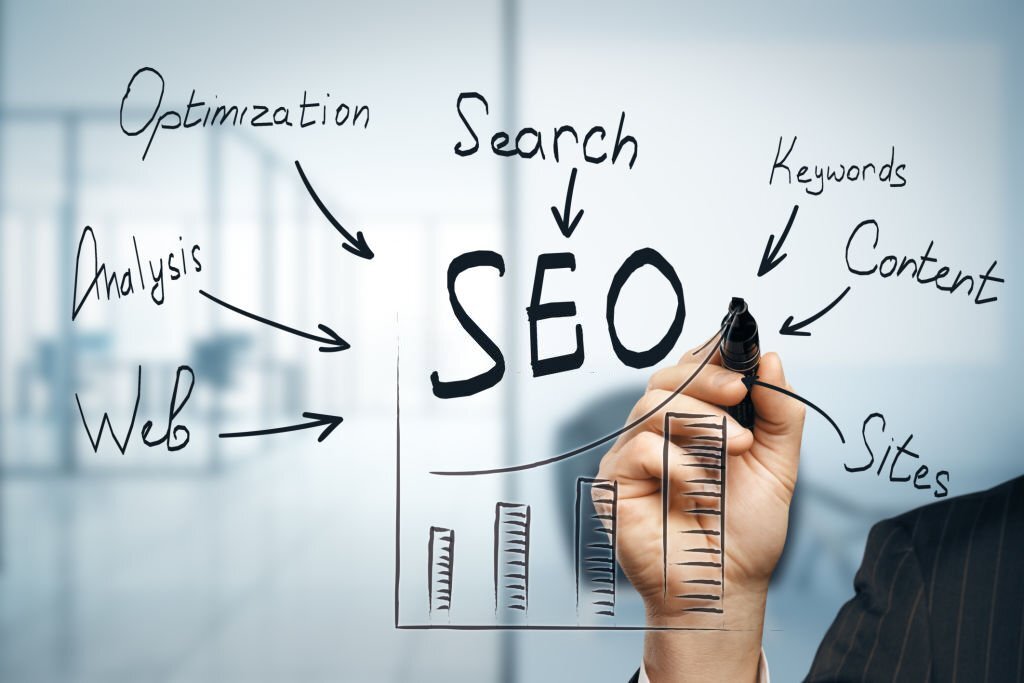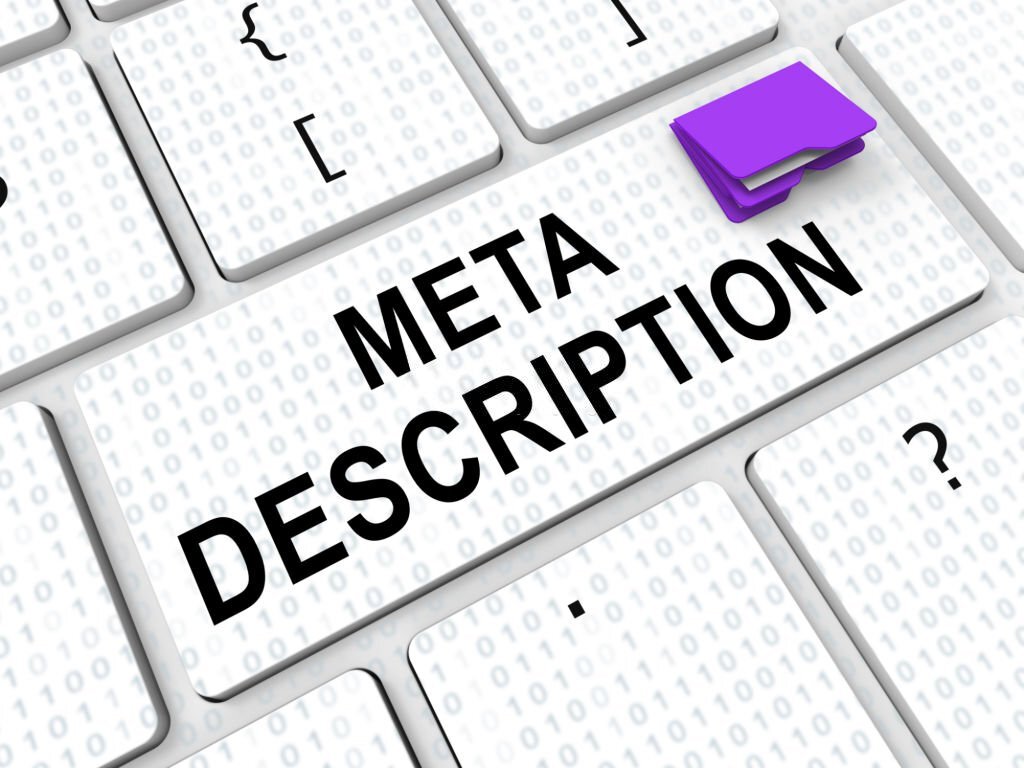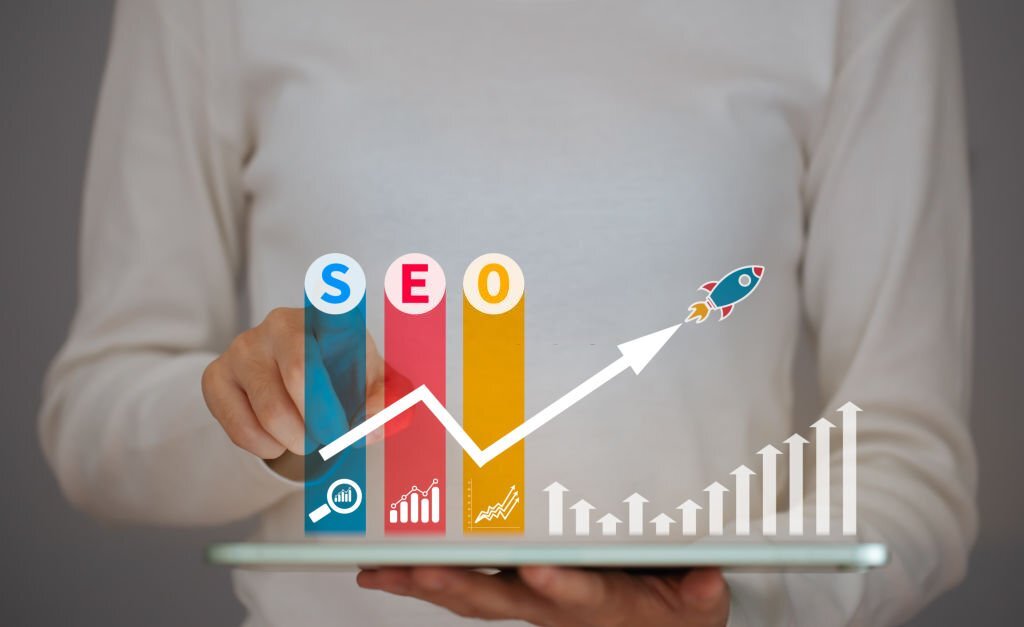If you just asked, “How can you improve your SEO rankings?” you’re in luck! In this article, we will teach you everything you need to know to optimize your website both on-page and off-page, so you can achieve the highest rankings possible for your website’s pages and blogs.
Let’s get started!
What is SEO?
What is SEO? If you look up the definition of SEO, it will tell you something like, “SEO is the process of implementing a set of on-page and off-page optimization techniques to improve your site’s performance and make sure that your content communicates all of the right signals to search engines so you can achieve higher rankings in search engine results pages.” (SERPs) — And they’re right.
But that doesn’t really answer the question, does it?
Most people who are curious about SEO want to know how to do it, how it works, how it can help their website, etc., and if they can do it themselves.
Here’s How SEO Works:

Every day, Google and other search engines send crawlers or what some call “spiders” out to check the web and read every website that exists online. They scan all of the content on each domain to try to find out what the pages are about on each website. Then, they put what they’ve found in something like a big library to file them. After that, they run about 200 ranking algorithms through the content to see who’s content deserves to be on the 1st page for a given search query.
Search Engine Optimization (SEO) is the process of optimizing your content so that it communicates what your page is about to these web crawlers so that they can rank you as high as possible for your content. The on-page SEO factors are the title tag, meta description, heading, subheadings, alt tags, and the URL assigned to the page.
Other factors come into play like formatting, scannability, readability, etc., but at the end of the day, what the search engine spiders are looking for is a quality user experience and coverage of the topic at the heart of the user’s search query. They want the search engine user to have whatever he/she wanted when they entered their search term into the search bar, and then they want it to be an engaging user experience so that the searcher enjoys it and comes back.
Pretty much the same thing you want for your website…
Want to Discuss How Growth Marketing Can Grow Your Business?
One of our growth marketing specialists would love to help!
Here are some statistics about SEO in case you’re not familiar with what SEO can do for your business:
- The #1 result (the zero position) in Google’s organic search results pages has an average click-through-rate (CTR) of 31.7%
- 61% of business-to-business marketers reported that the organic traffic generated by SEO brings in more leads than any other type of marketing
- 70% of marketers claim that SEO generates more sales than PPC
- SEO leads have an average close rate of 14.6%
- 75% of people never make it to the second page of a search engine’s search results pages
- 0.78% of searchers click on results from the second page
- Investing in content marketing, 10% report not using content marketing, and 8% are unsure if their company uses content marketing (HubSpot).
- 71% of marketers reported that targeting strategic search terms is their #1 focus when it comes to SEO
With a little bit of work and determination, your website will be seen a lot more on search engine results pages for the keywords that matter the most to your business. So in essence, SEO is one of the most important factors to look at when it comes to your website and its performance online. In short, SEO is how people find you unless you’re running paid ads, and whether or not your service or product pages show up in SERPs when someone nearby enters a local-intent search term. SEO is one of the most cost-effective and longest-lasting forms of digital marketing, and in the online world— It’s critical to your business.
The next section will explain what is the difference between SEO and SEM, to give you a quick understanding of each term and let you know how they differ..
What is the Difference Between SEO and SEM
The difference between SEO and SEM is that they are two totally different types of digital marketing. While search engine optimization (SEO) focuses on on-page and off-page optimization, the content on your site, your site’s performance, etc., search engine marketing (SEM) is a much broader term that encompasses SEO, keyword research, competitive analysis, and paid advertising,
Search engine marketing (SEM) involves research, submission, positioning, and optimization of a website within search engines to maximize visibility, traffic referrals, and paid traffic; but the majority of times you will hear the term thrown around, it will most likely be referencing paid ads. (pay-per-click advertising, like on Google ad network, or Bing or Yahoo paid ads.)
What’s the Difference Between SEO and Content Marketing
The difference between SEO and content marketing is that SEO is more technical than content marketing. While SEO involves keyword optimization, creating titles with a high click-through rate, (CTR) page formatting and readability, improving site performance, and internal and external linking, content marketing focuses solely on building content that engages users and adds value to increase revenue.
In other words, SEO mainly focuses on how your pages interact with search engines, and content marketing focuses on how your content interacts with people. These two types of marketing used together are very powerful. They can literally make or break a business online.
The next section will define and give examples of the main on-page SEO factors so that you understand how to do it and you can start optimizing your site’s content for higher rankings.
What Growth Marketing Can Do for Your Business
The term growth marketing refers to a well-thought-out marketing process that implements key digital marketing techniques such as; search engine optimization, value-driven content marketing, email marketing campaigns, creative advertisements, A/B testing, and more. Growth marketing focuses on recording key metrics for the purpose of analyzing and fine-tuning to achieve an effective and sustainable growth strategy.
Growth marketing is more effective than search engine optimization— Even search engine optimization and content marketing combined because it involves multiple marketing techniques and data-driven metrics to identify and refine every aspect of the campaign.
Is Your Marketing Plan Getting Your Business the Best Results Possible?
With more than 30 years of combined experience, our expert marketing team specializes in developing growth marketing strategies that achieve the best results possible for your business’ growth— And have the highest potential for success.
On-Page Optimization Factors
Whether you’re a growing, thriving business, the owner of a dozen sites, an SEO specialist at a web agency, or a self-taught SEO expert who’s passionate about figuring out how SEO works, this next section will give you an overview of the basics of on-page optimization techniques that you can start performing on your existing content and using to optimize anything you publish from here on out.
While optimizing your content for search engines to find it online will not automatically rank your site at the top of Google Search results, these on page optimization factors and the list of on page optimization tips that follow will make your content easier for search engines to crawl, rank, and index, create a better user experience for your visitors, and ensure that your content is communicating all of the correct signals about your content to ranking algorithms.
Title Tags
A title on each page helps Google, other search engines, and your visitors understand what the content on your page is about. It allows Google’s spiders, or, as they like to call it, “Googlebots” to see the page’s contents the way that we see and understand its contents when we look at it.
How to Check Your Webpage for a Title Tag
Create unique title text for each page on your site by placing the title> element inside the head> element of your pages. Here, let’s take a look at one…
If you click your right mouse button and scroll to the very bottom of the popup that appears and click inspect, (ctrl + shift + j on Windows/cmd + shift + c on Mac) you will notice a section with a bunch of writing in it. This is the HTML, text, and other elements that make up the page you’re on right now.
Now, if you were to open the head section tags at the top of that pane with all of the page information in it or press “ctrl” and “f ” together and search for the word “title”, you would find one kind of like the one in the screenshot above with the kitty. This is where your title goes that tells what the page is about.
The next section will tell you how to add or change a title tag:
How to Add a Title Tag to Your Webpage
How to add a title tag to your WordPress site without a plugin:
Just write a title into the title bar in the WordPress editor, and whatever you enter will be automatically inserted into the title tags of the page.
Another way that you can add a title tag to your web page in WordPress:
- Download the Yoast extension.
- Go back to the page you want to add a title on
- Save or refresh if you were already there and reload the page
- Scroll down the page until you see the SEO Title box
- Enter your title in the box that says “SEO Title”
- Click update to save your changes
Tips for Writing the Best Title Tag for Your Blog, Page etc.
In the screenshot above, you will notice that the choices for “Best recipe for a romantic dinner” have catchy titles that you would want to click on if you were planning a romantic dinner and searching online for something to cook for your better half.
Which one would you click on? The one that says 40? Same here.
More choices = more chances to find something exquisite for a romantic dinner.
These bloggers both have their ideal prospect in mind, because they know that no one wants to click on page after page in search results looking at only one recipe per page. That would take forever! Bloggers know this… And they use it in their titles to fish watery-mouthed romantic recipe finders in.
So that’s how you want to craft your titles. Here are some more tips for writing the best titles for your blog, page, etc.:
Be Mindful of the Competition – Put some time into thinking up the perfect title. You want to make sure people are inclined to click on your link in the midst of your competitors who also covered the topic.
Choose the Perfect Keywords – Choosing a low competition keyword that you believe bring prospects to your site, and even a longtail keyword in the subtitle (when it can be done without sacrificing quality) is the perfect way to let search engines and targeted users who are searching for your topic know that you’re there and you want to help them with what they are looking for.
Grab their Attention – Try to make your title pop and stand out! Words in all capitals like FREE in a title are attention getters when used right. Ideally, you want to come up with something so perfect that it will look irresistible for searchers.
Don’t Overdo it – We mentioned using words like FREE to get attention, but TITLES LIKE THIS ARE HARD TO READ… and they make you seem like you’re yelling.
Keep the Length Down – You want to try to stay under 60 characters for the title, mainly because the shorter titles tend to perform up to 45% better, and your title can get truncated if it’s too long.
Write for People – People are in a rush. They’re human, they have aches and pains, annoyances and frustrations, and hopefully, they crack up laughing as we do. Words like “Quick” when they are rushing around trying to get the steps to do something— Could only bless them. Checklists, tips, templates, etc., are all click-bait.
Next, we will be discussing meta descriptions and how to optimize them for search.
Meta Descriptions
Meta descriptions sit just below the title and link in search engine results pages to give a little preview of the page’s contents, (above) so that searchers can get a feel of what it will be like to read each search result for a query. The meta description is placed in the head> section along with the title> tag.
Here is how it looks at the head of the HTML page:
<META NAME=”Description” CONTENT=”interesting description here”>
The next section will tell you how to add or change a title tag:
How to Add a Title Tag to Your Webpage
A well-written meta description should increase click-through rates, build trust and credibility, stand out and get attention among competitors, and make a perfect first impression for any new visitors that click on your link in search results.
How to add a meta description to your WordPress site without a plugin:
To create custom meta descriptions, you don’t need to install an SEO plugin. You can just edit your theme files instead. Adding descriptions to individual pages can be a bit of a pain, but here is how to do it:
Back up your website first!
In your left menu, go to Appearance > Theme Editor
Look in the right-hand sidebar and find the Theme Header (header.php)
Add the tag below to your header.php file anywhere between the two head> tags
Add your meta description
Another way that you can add a meta description to your web page in WordPress is to:
Download the Yoast extension.
Go to the page you wish to add a description on
Add your description to the meta description box below the editor.
Tips for Writing the Best Meta Description for Your Blog, Page etc.

Meta descriptions are helpful to search engine users because they identify and confirm the contents of the page. But since you will be forced to compete for attention in SERPs, it’s a good idea to be as creative as possible with your description. If your content is time sensitive, like information promoting an event, or localized, like a local service page targeting a nearby city, it’s a good idea to reflect that in the meta description as well.
In addition, if you can squeeze your keyword in the meta description as well, it’s good practice to try to work it in. Just mind the length of your meta descriptions, because they are risking truncation at 155 characters, and keep your mind on saying the perfect thing to win over the hearts of your prospects and get them to your page and you will write amazing meta descriptions!
Here are some tips on coming up with the perfect meta description for your blog, page, etc.:
Watch Your Meta Description Length – Try to keep your meta descriptions below 155 characters in length so they don’t get truncated by Google.
Be Creative and Interesting – Try to be creative and interesting. If you offer something that your competition does not offer, have a new idea or angle that hasn’t been discussed much online, etc., this can only help your meta description stand out and get attention.
Keyword Usage – Try to use your keyword, or a long-tail variation of your keyword in the description whenever possible.
Avoid Duplicate Descriptions – You should avoid writing identical descriptions on your pages and posts because search engines frown on this and it can take points off your SEO score.
Next, we will be discussing the importance of internal links, and how to optimize them for search.
Internal Links
Internal links are links from one page of your website to another. Both search engines and users benefit from internally linked pages because they assist both with navigation and understanding the relationship between pages on your site. By using internal linking on your website, your pages can be categorized and defined in a hierarchy and identified by importance.
In search engines, links hold a given amount of link equity, also known as ‘link juice and are considered a ranking factor as they convey the authority and value of the page. Search engines, while crawling your site, have been programmed to realize that your well-researched blog post has been linked from another authoritative site and that that site considers your blog post to be important. So another site linking to your website is kind of like a vote of confidence.It— Just another way that search engines can tell if you have good content.
There Are 4 Types of Internal Links
There are 4 types of internal links on your site: navigational links, contextual links, sidebar links, and footer links:
Navigational Links: Navigational links are, for example, your primary or footer menu links. Store, About Us, Blog, Contact Us; these are navigational links.
Contextual Links: Contextual links link to other pages from inside your content. Links from a section of a page or blog to other blogs, topic clusters, pillar pages, whitepapers, etc., are some examples of contextual linking.
Sidebar Links: Sidebar links are generally linked to recent news or blog posts that you’ve published, upcoming events or social media feeds.
Footer Links: Footer links are generally additional navigational links, maybe maps and addresses, social media buttons, or company-related links and resources.
How to Improve Internal Linking
When you use internal links correctly, it sends a signal that your pages are related to one another to search engines, and makes it easier for readers to navigate your site by interest. The best way to link internally is to have your authoritative content in topic clusters and then woven together for easy access.
Link Relevant Pages Together
Link relevant pages together to form topic clusters in your areas of expertise. This promotes an engaging user experience, builds authority and credibility, and increases all of your most important metrics. It’s also great for SEO and the search engines love it!
Use Keywords as Anchor Text
Using keywords as anchor text will ensure that your visitors are able to easily tell where the link goes on your site.
Content-Related On-Page Optimization Factors
Content Quality – Content quality gets the highest priority out of all of the on-page factors.
Without content that offers an engaging, and valuable user experience, you can bring in all the traffic that you want, but you won’t keep them.
Search Intent – It makes a big difference if your content is designed to help the readers with their search queries. Google and other search engines wouldn’t get paid if their patrons searched all day and left feeling frustrated.
Website Speed – Webpage load time is a crucial factor in ranking your website. The longer your page takes to load, the less your SEO score, and the fewer people are coming to, staying on, and returning to your site.
SSL Certificate – As of 2019, SSL certificates are mandatory for websites to be classified as secure by Google. SSL certificates check the validity of websites and enable encrypted connections. Online stores that require personal details like credit or debit card numbers commonly use SSL certificates.
Keywords Density – It’s considered good practice to have your target keywords in the first 100 to 150 words of your content. It lets your visitors and search engine web crawlers know that your content was designed to cover the topic that they are looking for. Subheadings should be keyword-rich as well when you can pull it off without sacrificing quality.
URL Structure – It is common for websites to use automatically generated URLs that are confusing to users and unreadable to Google. Customized URLs, on the other hand, can help you optimize your website and be clear to distinguish and navigate to search engines and visitors.
Image Optimization – Image optimization is another on-page SEO factor that gets forgotten a lot. A descriptive alt text and file name that explains what’s in the picture should be added to every image on your site. Your page content will be understood by Google bots if the image alt text is well-thought-out. They also ensure that your content is accessible to people who may use assistive readers or similar assistive devices or technology.
Review or FAQ Schema – Reviews are read by a large percentage of people before making an online purchase. Customers will feel more confident about your business when they see positive reviews on your website.
The schema does not help with SEO directly, but it may help your website show up in rich snippets in the search engine results pages. When your site’s pages show up in rich snippets, you get more visibility and more traffic because it puts you in front of users in an engaging way.
Optimize for Voice Search – Voice searches account for about 50% of all searches, and that number is increasing rapidly every year. Having your pages and blogs’ voice search optimized is an important on-page factor, especially if you sell products or offer localized services.
Off-Page Optimization Factors
In contrast to on-page optimization, which optimizes the content within your website to improve SERP rankings, off-page optimization optimizes factors outside your website to improve SERP rankings. Those ranking factors can also be positively impacted by off-page SEO techniques.
Off-page techniques are more time-consuming to deal with than being able to fix something right there on your website, but they work wonders for your site’s organic performance and can be very rewarding when approached correctly.
Below, we’ve outlined the direct off-page ranking factors so that you can become acquainted with them and start learning how to achieve the online presence that you want for your business.
Backlink Profile
Experts estimate that your backlink profile accounts for over 50% of your total organic rankings. Backlinks alone are estimated to account for 15% of organic rankings for Local Pack results; 31% for local organic results.
Linking Root Domains – When you are curating valuable content for search engine users, sites will naturally link to your site to show you off. Even though buying big lots of links can get you penalized now, in general, the more unique linking root domains that link to your website, the better.
Quality Links: Links from high domain authority (DA) websites are considered quality links. The more popular the site is, the more link equity a backlink will pass on to your content.
Link Relevance: If you own a local auto repair shop, a link from a used car dealership would be worth more than a link from a local hardware store.
Dofollow Links: The term “dofollow,” means that search engines can follow the links and pass along link equity. The term “nofollow,” means search engines do not follow the links or pass along link equity.
Anchor Text: Google uses anchor text to understand the relevance of pages. Anchor text is the text part of the hyperlink that you can visibly see as a reader and click on.
Referral Traffic – Backlinks are also considered valuable when they send referral traffic to your website.
Brand Mentions – Brand mentions are linkless instances of your brand name mentioned online, whether in an article, a case study, on social media, within a forum, or somewhere else.
Review – Reviews are the second most important ranking factor in Local Pack results, according to Whitespark. Review sentiment, quantity, diversity, velocity, and review site domain authority are all believed to have an effect on rankings.
Online Footprint (Reach) – No matter what off-page tactics you deploy, if you want to increase brand mentions at an effective rate, you need more people to know you exist. Which means doing things that maximize reach. Prioritize opportunities that will put you and your point of view in front of the most people.
Tips for Building Backlinks
With a better understanding of which off-page ranking factors matter most, you can start looking at ways to strengthen your brand presence online and start building your market share.
Here are some tips on how to start building backlinks:
Content Marketing and Distribution – One of the best ways to build backlinks online is through content marketing and distribution. When you are constantly publishing helpful content, your visibility increases. The more people you reach, the more people will have a chance to link out to your site.
Social Media Marketing – Social media is a great way to get shares and likes from other users and build natural backlinks to your site.
Guest Blogging – Guest blogging, whether it’s paid guest post or a guest post opportunity that you acquire through manual outreach, is a great way to get authority backlinks while soaking up some referral traffic in the process.
Influencer Marketing – If you can find influencers in your niche who are willing to share your content with their followers, you could potentially pick up additional shares, likes, followers, and backlinks.
Press Releases – The greatest benefit of a press release optimized for SEO is its indirect value. A press release appearing in the “News” section of SERPs might drive organic traffic to your site, increasing your brand awareness and buzz. Linking to the press release site has direct value as well.
Link Acquisition – Link acquisition refers to building a network of relationships with influencers, which is a more ethical tactic. Instead of buying influencers, work with them to build lasting relationships and generate results.
Content Syndication – Syndication of content is where your owned content is republished on another website. By introducing the content to new audiences, content syndication increases its reach. By syndicating your content, you can increase your reach and drive traffic to your website.
Conclusion
We hope that this article has helped you understand how you can improve your SEO ranking. SEO is one of the most effective and longest-lasting ways that you can grow your business online. When paired with content marketing— It can make your business a huge success!
Lean Summits specializes in growth marketing for businesses. We focus on customer awareness, customer acquisition, and customer retention at every stage of the buying funnel. Then we test, compare, and rework our processes until we get you the highest ROI possible. Call now to speak with one of our growth marketing team members!



